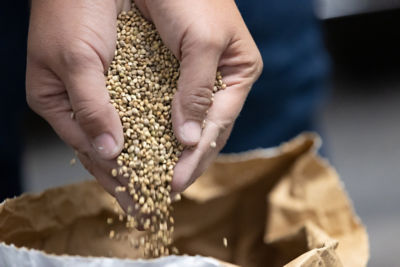Click here to download a PDF version of this spotlight.
» Cucumber mosaic, papaya ringspot, watermelon mosaic, zucchini yellow mosaic, and squash mosaic are important viral diseases of summer squash.
» Symptoms of mosaic virus diseases are similar; typical symptoms include wrinkled, curled leaves, mosaic or mottling on new leaves. The symptoms are so similar that it is difficult to distinguish these diseases based only on symptoms.
» Host resistance, preventing the spread of viruses, and the use of virus-free seeds can help manage these virus diseases, depending on the specific virus.
CUCUMBER MOSAIC
The disease, cucumber mosaic, is caused by the Cucumber mosaic virus (CMV). CMV is one of the most common and destructive cucurbit viruses, and it is widely distributed throughout temperate and tropical areas of the world.1,2 CMV can infect over 1200 plant species, including monocots and dicots.3 There are many strains of CMV, and they differ in the symptoms they cause, the range of hosts they infect, and their means of dispersal.4 Yield losses of 10 to 20% are common, and losses of up to 100% can occur.3
Squash plants can be infected with CMV at any stage, and once a plant is infected, the virus spreads systemically within the plant. Symptoms appear 7 to 14 days after infection and develop most quickly at 79 to 89°F.1,3,4 A yellow mosaic or mottling appears first on the youngest leaves (Figure 1A). New leaves are stunted and distorted, with the outer edges curling downward.3,4 Plants are stunted, sometimes severely, with shortened internodes resulting in a bushy canopy. Flowers can show abnormal features such as green petals. Fruit set is often reduced, and fruit produced on infected plants are usually smaller, somewhat deformed, and show mottling or green dots on the skin (Figure 1B).1
Many crops, ornamentals, and weed species can serve as reservoir hosts of CMV. Weed hosts include bur-cucumber, burdock, common milkweed, horsenettle, jimsonweed, marsh yellowcress, nightshades, pigweed, pokeweeds, white cockle, and wild-cucumber. Perennial hosts, such as alfalfa, are important reservoir hosts in regions with cold winters.1,3,4
 Figure 1. (A) Mosaic and deformation symptoms on squash leaves and (B) mosaic symptoms on fruit.
Figure 1. (A) Mosaic and deformation symptoms on squash leaves and (B) mosaic symptoms on fruit.
WATERMELON MOSAIC / PAPAYA RINGSPOT
Once thought to be different strains of the same virus, Papaya ringspot virus – watermelon strain (PRSV-W) and Watermelon mosaic virus (WMV) are now recognized as distinct viruses. WMV has a host range that includes most cucurbits, many legume species, and other plants such as carrots and spinach. WMV is found worldwide in most cucurbit growing regions. In the U.S., watermelon mosaic occurs most commonly in the southern and western growing regions, New Jersey, and New York.1 Yield losses above 50% from WMV infection are not uncommon. The host range of PRSV is mainly limited to cucurbits, but it also infects species of Chenopodium, and PRSV-W is most commonly found in tropical and subtropical regions.
The symptoms resulting from WMV and PRSV infection are similar. All plant parts can be affected, with the severity of symptoms depending on the age of the plant at the time of infection. Earlier infection results in more severe symptoms. A green- to dark-green mosaic with vein banding occurs on squash leaves, and leaves may show narrow, elongated growth and blistering if infected when young (Figure 2).1 PRSV infection can substantially reduce fruit set, and any fruits that develop may be deformed and discolored. The fruit of WMV infected plants are typically stunted, gnarled, and sometimes knobby. Mixed infections of WMV and CMV are common, especially later in the season. WMV can overwinter on annual and perennial legumes such as clover, while PRSV-W usually spreads from wild perennial cucurbit hosts.
 Figure 2. Foliar symptoms of leaf deformation, blistering, vein banding, and severe mosaic.
Figure 2. Foliar symptoms of leaf deformation, blistering, vein banding, and severe mosaic.
ZUCCINI YELLOW MOSAIC
The Zucchini yellow mosaic virus (ZYMV) can be found worldwide in cucurbit growing regions. ZYMV mainly infects cucurbits. Non-cucurbit hosts have been reported, but these are probably not very important in spreading the disease to cucumbers.1,2 Symptoms include prominent yellow mosaic and vein clearing symptoms on leaves, leaf distortion, and stunted plants. Fruits produced on infected plants may be severely deformed and discolored.2
SQUASH MOSAIC
The Squash mosaic virus (SqMV) is different from the viruses above in that it is transmitted by cucumber beetles, not aphids, and the virus can be seed transmitted. Squash mosaic is not as common in the U.S. as it once was because of the use of virusfree seeds. Symptoms include mosaic, mottling, and green vein banding patterns on leaves. Fruit on infected plants may also show mottling, and yield levels can be reduced.1
MANAGEMENT OF MOSAIC VIRUS DISEASES
The most effective way of managing mosaic virus diseases is by using resistant varieties. While most cucumber varieties have resistance to CMV, and there are many varieties with resistance to WMV and ZYMV, resistance to these viruses is less common in squash varieties. Some squash varieties have interspecific resistance to CMV, ZYMV, PRSV, and WMV. These forms of resistance were brought in by crossing squash with other Cucurbita species.5,6 Moving these forms of resistance between species has been difficult. Transgenic squash varieties have been developed that contain the coat protein gene from some of these viruses, and that has provided resistance to CMV, WMV, and ZYMV. Some yellow squash varieties contain the precocious yellow gene, that does not convey resistance, but it does mask the green mosaic symptom on the fruit, so that the fruit remains marketable.1,7
CMV, PRSV, WMV, and ZYMV are transmitted by several species of aphids in a non-persistent manner. With non-persistent transmission, the aphid aquires the virus after feeding on an infected plant for a few seconds to minutes. The aphid can then transmit the virus to a healthy plant very quickly, but it only retains the virus for a short time, often for only a few hours or until the aphid starts feeding. To lower the infection rate by these four viruses, squash crops should not be planted near or downwind of established plantings of hosts that may be infected with any of the viruses. Planting early in the spring can allow the crop to become established before aphids arrive to spread the viruses, and the use of reflective mulches and row covers can help keep aphids away from plants early in the season. Reflective mulches repel aphids but lose effectiveness as the canopy covers the mulch. Row covers act as a physical barrier to aphids, but they must be removed when plants start to flower to allow pollinators access to the flowers.1,3
Weed management of reservoir hosts in and around fields and greenhouses can help lower the rate of virus spread. Still, it can be difficult, especially for effective management of CMV, because of its very wide host range.1,3 Weed control early in the season has the most impact. Weeds should be cleared from an area of at least 10 feet around greenhouses. The elimination of reservoir hosts to at least 100 yards around production fields is recommended to reduce virus spread.4
Managing aphids with insecticides is generally not effective for reducing the spread of non-persistently transmitted viruses because the viruses are introduced into the plants before there is time for the insecticide to kill the aphid.3 The application of mineral oils can help slow the spread of the viruses because the oil interferes with the release of the virus from the aphid’s stylet.4 Using insecticides to manage cucumber beetles can help manage SqMV infection in areas where the virus is present. Virus-free seed is the primary method used to manage SqMV.1
If feasible, roguing virus-infected plants early in the season can help reduce the spread of viruses within a planting. Also, planting a non-host trap crop, such as wheat, around a squash field can help to “clean” the aphids of viruses as they feed on the trap crop before moving to the squash.4 Prompt destruction of crop debris after harvest can help prevent the spread of these viral diseases to other nearby plantings.1
SOURCES
1 Keinath, A., Wintermantel, W., and Zitter, T. 2017. Compendium of cucurbit diseases and pests. American Phytopathological Society. St. Paul, MN.
2 Zitter, T. A. and Banik, M. T. 1984. Virus diseases of cucurbits. Vegetable MD Online. Cornell University. Fact Sheet Page: 732.40.
3 Zitter, T. and Murphy, J. 2009. Cucumber mosaic. The Plant Health Instructor. DOI: 10.1094/ PHI-I-2009-0518-01.
4 Babadoost. M. 1999. Mosaic diseases of cucurbits. Report on Plant Disease. University of Illinois Extension. RPD No. 926.
5 Webb, S. and Tyson, R. 1997. Evaluation of virus resistant squash varieties. Proc. Fla. State Hort. Soc. 110:299-302.
6 Zitter, T. 2014. 2014 Summer and winter squash varieties for virus and PM tolerance. Vegetable MD Online.
7 Boyhan, C., Brown, J., Channel-Butcher, C., and Perdue, V. 2000. Evaluation of virus resistant squash and interaction with reflective and nonreflective mulches.
HortTechnology 10:574-580.
ADDITIONAL INFORMATION
For additional agronomic information, please contact your local seed representative. Performance may vary from location to location and from year to year, as local growing, soil and weather conditions may vary.Growers should evaluate data from multiple locations and years whenever possible and should consider the impacts of these conditions on the grower’s fields. The recommendations in this article are based upon information obtained from the cited sources and should be used as a quick reference for information about squash production. The content of this article should not be substituted for the professional opinion of a producer, grower, agronomist, pathologist and similar professional dealing with this specific crop.
BAYER GROUP DOES NOT WARRANT THE ACCURACY OF ANY INFORMATION OR TECHNICAL ADVICE PROVIDED HEREIN AND DISCLAIMS ALL LIABILITY FOR ANY CLAIM INVOLVING SUCH INFORMATION OR ADVICE. 6611_38850 Published 05-26-2022
Bayer, Bayer Cross and Seminis® are registered trademarks of Bayer Group. All other trademarks are the property of their respective owners. ©2022 Bayer Group. All rights reserved.




